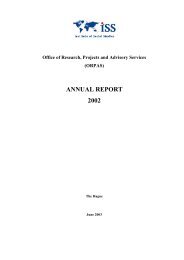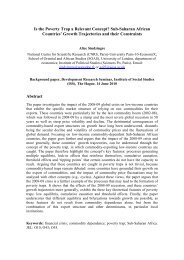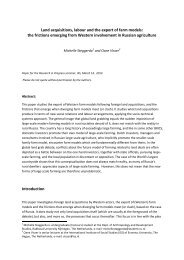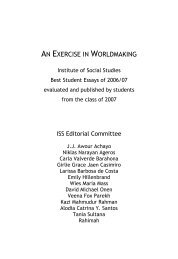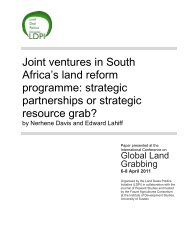AN EXERCISE IN WORLDMAKING 2009 - ISS
AN EXERCISE IN WORLDMAKING 2009 - ISS
AN EXERCISE IN WORLDMAKING 2009 - ISS
You also want an ePaper? Increase the reach of your titles
YUMPU automatically turns print PDFs into web optimized ePapers that Google loves.
6 The Utility of the Citizen: Relating Citizenship in Social Movement Activity 67<br />
point, offering an examination of what it means to be included or excluded<br />
from the political sphere or society. Speaking to social constructs<br />
of gender or discrimination are a few of the ways citizens are socially and<br />
systematically excluded. This very dilemma is of concern to Naila Kabeer<br />
(2005), who suggests that there are values which people associate with<br />
the idea of citizenship. This commonality exists through a fundamental<br />
connection of experienced exclusion, which provides a basis for the imagination<br />
of a more inclusive structure (3). While inclusive citizenship is<br />
but on example of an emerging concept applied to citizenship, it represents<br />
a move towards understanding citizenship as something that is not<br />
simply given due to territoriality. It is a process of struggle for consideration,<br />
inclusion and rights. This particular understanding of citizenship<br />
closely resides with individuals and communities such as migrants, who<br />
are often denied the rights associated with citizenship on the basis that<br />
they are not a national of their country of residence.<br />
To provide an example, resistance movements have often been noted<br />
for their ability to expand the state-given framework of inclusion, replacing<br />
it with a radicalized version that defines inclusion from the perspectives<br />
of those who are excluded (Mohanty 2006: 82). Under the neoliberal<br />
institutional model adopted in South Africa, the APF is one of many<br />
movements seeking to crumble state and its partner’s perceptions of social<br />
progress and inclusion for marginalized communities. Following the<br />
break from apartheid in 1994, the African National Congress (<strong>AN</strong>C) began<br />
to form a state under an assumed “trickle down effect” from neoliberal<br />
institutional arrangements such as the Reconstruction and Development<br />
Programme (RDP) and its subsequent replacement by the Growth,<br />
Employment and Redistribution Strategy (GEAR). Strongly situating<br />
itself within socialist tradition, the APF was created in order to provide a<br />
platform for solidarity and information-sharing for communities and<br />
groups of the left that had broken from alliances with the <strong>AN</strong>C, and<br />
who were seeking a space to express their concerns. In turn, the APF became<br />
a movement for organizations, individuals and associations alike in<br />
order to challenge governmental and private companies’ systematic exclusion,<br />
which denied citizens access to basic goods and services (Buhlungu<br />
2004: 4). Therefore, as social movements are involved in an active<br />
process of imagining new mechanisms or opportunities for inclusion, citizenship<br />
becomes a crucial reference point upon which they contest this<br />
exclusion. The movements themselves can become a space to counter




